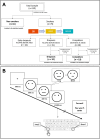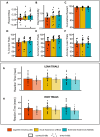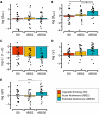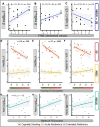Longitudinal changes in reinforcement learning during smoking cessation: a computational analysis using a probabilistic reward task
- PMID: 39741189
- PMCID: PMC11688494
- DOI: 10.1038/s41598-024-84091-y
Longitudinal changes in reinforcement learning during smoking cessation: a computational analysis using a probabilistic reward task
Abstract
Despite progress in smoking reduction in the past several decades, cigarette smoking remains a significant public health concern world-wide, with many smokers attempting but ultimately failing to maintain abstinence. However, little is known about how decision-making evolves in quitting smokers. Based on preregistered hypotheses and analysis plan ( https://osf.io/yq5th ), we examined the evolution of reinforcement learning (RL), a key component of decision-making, in smokers during acute and extended nicotine abstinence. In a longitudinal, within-subject design, we used a probabilistic reward task (PRT) to assess RL in twenty smokers who successfully refrained from smoking for at least 30 days. We evaluated changes in reward-based decision-making using signal-detection analysis and five RL models across three sessions during 30 days of nicotine abstinence. Contrary to our preregistered hypothesis, punishment sensitivity emerged as the only parameter that changed during smoking cessation. While it is plausible that some changes in task performance could be attributed to task repetition effects, we observed a clear impact of the Nicotine Withdrawal Syndrome (NWS) on RL, and a dynamic relationship between craving and reward and punishment sensitivity over time, suggesting a significant recalibration of cognitive processes during abstinence. In this context, the heightened sensitivity to negative outcomes observed at the last session (30 days after quitting) compared to the previous sessions, may be interpreted as a cognitive adaptation aimed at fostering long-term abstinence. While further studies are needed to clarify the mechanisms underlying punishment sensitivity during nicotine abstinence, these results highlight the need for personalized treatment approaches tailored to individual needs.
Keywords: Decision-making; Nicotine abstinence; Punishment sensitivity; Reinforcement learning; Smoking cessation; Withdrawal.
© 2024. This is a U.S. Government work and not under copyright protection in the US; foreign copyright protection may apply.
Conflict of interest statement
Declarations. Competing interests: The authors declare no competing interests.
Figures





Similar articles
-
Neural Signatures of Cognitive Flexibility and Reward Sensitivity Following Nicotinic Receptor Stimulation in Dependent Smokers: A Randomized Trial.JAMA Psychiatry. 2017 Jun 1;74(6):632-640. doi: 10.1001/jamapsychiatry.2017.0400. JAMA Psychiatry. 2017. PMID: 28403383 Free PMC article. Clinical Trial.
-
Smoking Decisions: Altered Reinforcement Learning Signals Induced by Nicotine State.Nicotine Tob Res. 2020 Feb 6;22(2):164-171. doi: 10.1093/ntr/nty136. Nicotine Tob Res. 2020. PMID: 29982681
-
Patterns of change in withdrawal symptoms, desire to smoke, reward motivation and response inhibition across 3 months of smoking abstinence.Addiction. 2009 May;104(5):850-8. doi: 10.1111/j.1360-0443.2009.02522.x. Epub 2009 Mar 13. Addiction. 2009. PMID: 19344444 Free PMC article.
-
[Smoking reduction and temporary abstinence: new approaches for smoking cessation].J Mal Vasc. 2003 Dec;28(5):293-300. J Mal Vasc. 2003. PMID: 14978435 Review. French.
-
Possible New Symptoms of Tobacco Withdrawal II: Anhedonia-A Systematic Review.Nicotine Tob Res. 2020 Jan 27;22(1):11-17. doi: 10.1093/ntr/nty171. Nicotine Tob Res. 2020. PMID: 30726957 Free PMC article.
Cited by
-
Reinforcement Learning in Personalized Medicine: A Comprehensive Review of Treatment Optimization Strategies.Cureus. 2025 Apr 21;17(4):e82756. doi: 10.7759/cureus.82756. eCollection 2025 Apr. Cureus. 2025. PMID: 40406780 Free PMC article. Review.
References
-
- U.S. Department of Health and Human Services. Smoking Cessation. A Report of the Surgeon General. Atlanta, GA (USA): U.S. Department of Health and Human Services, Centers for Disease Control and Prevention (National Center for Chronic Disease Prevention and Health Promotion, Office on Smoking and Health, 2020).
-
- Hughes, J. R., Keely, J. & Naud, S. Shape of the relapse curve and long-term abstinence among untreated smokers. Addiction99 (1), 29–38 (2004). - PubMed
-
- Hughes, J. R. Tobacco withdrawal in self-quitters. J. Consult. Clin. Psychol.60 (5), 689–697 (1992). - PubMed
-
- Bouton, M. E. Learning and Behavior (Sinauer, 2016).
Publication types
MeSH terms
Grants and funding
LinkOut - more resources
Full Text Sources
Medical
Miscellaneous

